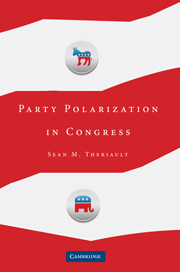1 - Party Polarization in the U.S. Congress
Published online by Cambridge University Press: 05 September 2012
Summary
One year to the date after the Supreme Court's Bush v. Gore decision brought the 2000 presidential election to an end, the House of Representatives passed the Help America Vote Act (HAVA). By passing the bill, which authorized $2.65 billion to help localities both update antiquated voting equipment and recruit, hire, and train poll workers, House members hoped they had solved the problems that led to the fiasco in Florida. Three hundred and sixty-two legislators, which included substantial majorities of both parties, voted for the bill's final passage; only 20 Republicans and 43 Democrats voted against it.
Congressional observers and the American public may have been surprised to see the House, an institution criticized for being trapped in partisan warfare, find a bipartisan solution to one of the most highly partisan episodes in American history. Indeed, Democrats and Republicans alike praised House Administration Committee Chair Bob Ney and Ranking Member Steny Hoyer for working together to insure that future ballots are properly cast and appropriately counted. Congressman Chaka Fattah, a Democrat on the committee, offered the following assessment during floor debate: “I want to thank Chairman Ney, who I think has exhibited extraordinary leadership in moving this forward, and Ranking Member Hoyer, [for] bringing together a bipartisan group of people.”
- Type
- Chapter
- Information
- Party Polarization in Congress , pp. 1 - 10Publisher: Cambridge University PressPrint publication year: 2008



